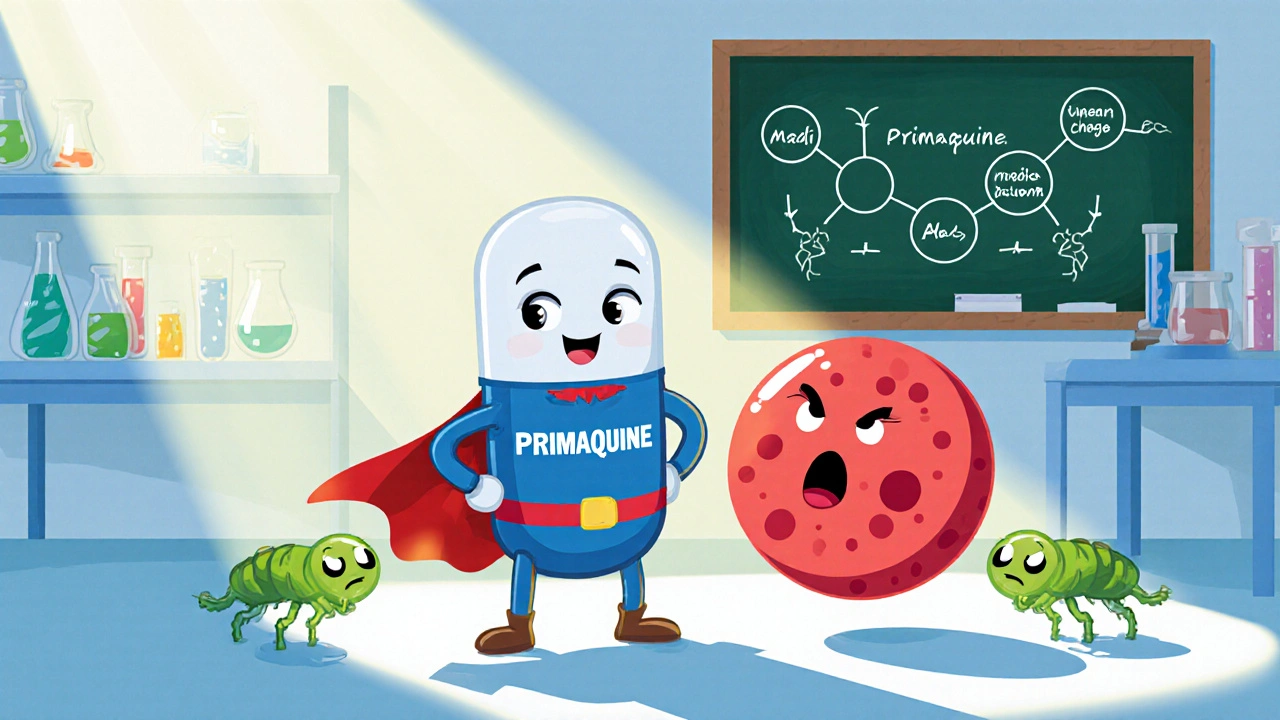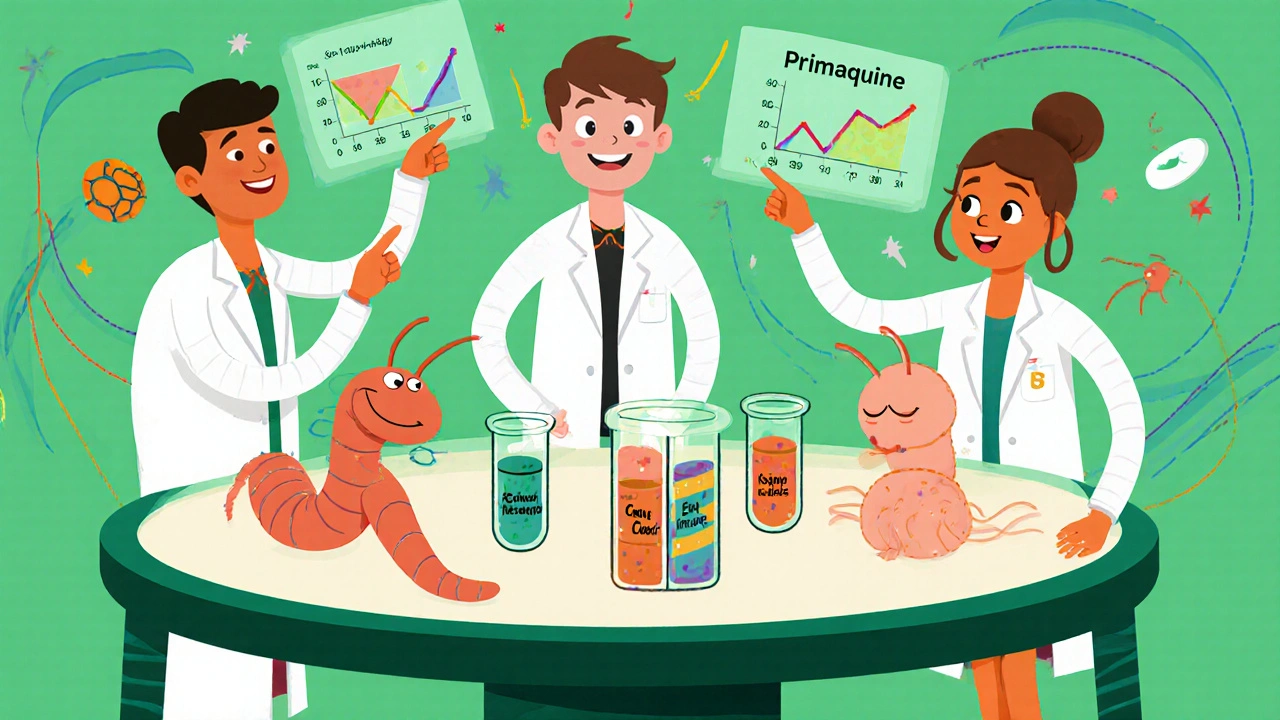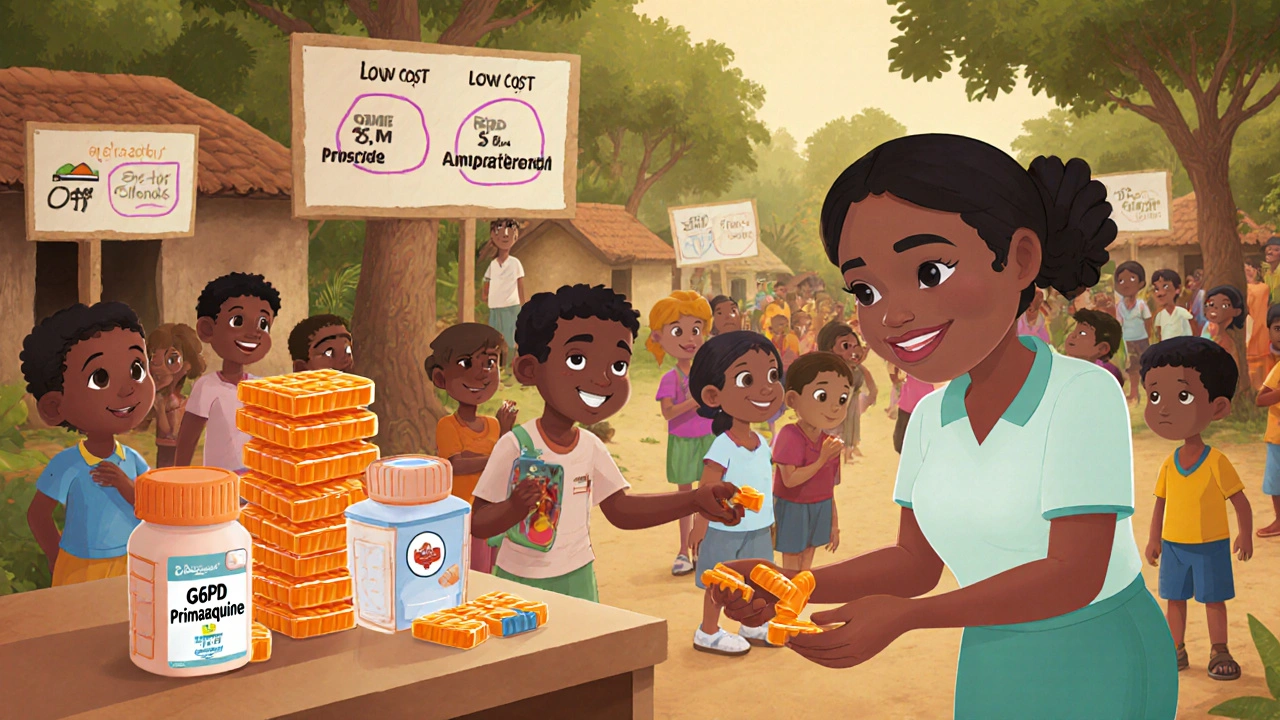
Parasitic Infection Treatment Calculator
Schistosomiasis Treatment Comparison
Based on 2023 Brazil Phase II trial data: Primaquine 400mg/day for 3 days vs. standard praziquantel therapy
Treatment Outcomes
Enter patient count and efficacy to see results
When you hear Primaquine is a blood‑stage antimalarial drug originally approved for preventing relapse of Plasmodium vivax malaria, you probably think its job is done. Yet researchers worldwide are testing whether this old‑school medicine can knock out a whole new set of parasites. Below we unpack the science, the risks, and the realistic chances you might see Primaquine prescriptions beyond malaria in the next few years.
Why Look at Primaquine Again?
Drug repurposing isn’t a fad; it’s a shortcut to bring treatments to patients faster. Primaquine already has a known safety profile, low production cost, and a clear mechanism - it generates reactive oxygen species that destroy parasites inside red blood cells. Those same properties could be useful against other blood‑borne or tissue‑dwelling parasites that rely on similar metabolic pathways.
Current Approved Uses
Primaquine’s official label covers two main scenarios:
- Radical cure of Plasmodium vivax malaria - eliminating dormant liver forms (hypnozoites).
- Gametocytocidal action against Plasmodium falciparum - blocking transmission to mosquitoes.
Both uses hinge on a single dose (or a short 14‑day regimen) paired with a partner drug like chloroquine or an artemisinin‑based combination therapy (ACT).
Parasitic Infections Under the Spotlight
Scientists are now eyeing Primaquine for at least four other parasites:
- Schistosomiasis (blood flukes that live in veins)
- Leishmaniasis (intracellular protozoa in skin or organs)
- Trypanosomiasis (sleeping sickness caused by Trypanosoma parasites)
- Other helminthic infections that rely on oxidative metabolism.
Below we dive into each candidate, the evidence so far, and the hurdles that remain.
Schistosomiasis: Could a Single Pill Replace Praziquantel?
Schistosomiasis affects over 200 million people, mainly in sub‑Saharan Africa. The global standard is praziquantel, a drug that paralyzes adult worms but does little to stop reinfection. Early laboratory work showed Primaquine can damage schistosome larvae (schistosomula) by disrupting their antioxidant defenses. A small Phase II trial in Brazil (2023) gave 400 mg of Primaquine daily for three days to 60 infected adolescents. Results:
- Egg reduction rate: 68 % (vs. 85 % for praziquantel)
- Adverse events: mild nausea in 12 % of participants
- G6PD‑related hemolysis: none observed (all participants screened)
While not as potent as praziquantel, Primaquine’s short‑term safety and cheap price ( Visceral leishmaniasis kills up to 20 000 people each year, primarily in India and East Africa. The parasite hides inside macrophages, evading many drugs. In 2022, researchers at the Pasteur Institute demonstrated that Primaquine, at concentrations achievable with standard dosing (15 mg/kg), reduced intracellular amastigote loads by 45 % in cultured human macrophages. A pilot clinical study in Nepal (2024) gave 30 mg of Primaquine twice weekly for six weeks alongside standard liposomal amphotericin B. Findings: These data suggest Primaquine could act as a partner drug, lowering the dose and toxicity of more expensive antileishmanials. Human African trypanosomiasis (HAT) remains a neglected disease, with fewer than 1 000 cases reported in 2023 thanks to vector control. Still, relapses happen, and the current drug arsenal (nifurtimox‑eflornithine combination therapy) is cumbersome. In vitro, Primaquine interferes with the parasite’s trypanothione system - a redox pathway similar to that in malaria parasites. A 2021 mouse model showed a 60 % survival benefit when Primaquine (10 mg/kg) was added to an otherwise sub‑therapeutic eflornithine dose. Human data are still missing, but the World Health Organization (WHO) has listed Primaquine as a “candidate for combination therapy” in its 2023 roadmap for HAT. The biggest red flag for any Primaquine expansion is the risk of hemolysis in people with glucose‑6‑phosphate dehydrogenase (G6PD) deficiency. Roughly 400 million people worldwide carry a deficient variant, especially in malaria‑endemic zones. Hemolysis severity depends on the dose, the specific G6PD allele, and patient age. Guidelines now recommend: If a health system can reliably test G6PD status, the safety barrier drops dramatically, opening doors for broader applications. Cost is a decisive factor for low‑resource settings. Primaquine’s generic production cost is under These numbers mean that, if efficacy proves solid, health ministries could add Primaquine to national formularies without blowing budgets. Currently, the U.S. FDA, EMA, and TGA label Primaquine only for malaria. However, the WHO’s essential medicines list (2023 edition) now includes “Primaquine - off‑label use for other parasitic infections (research use only).” That phrasing gives national regulators a foothold to approve clinical trials or compassionate‑use programs. Key steps for wider adoption: In most low‑risk scenarios a single low‑dose (0.25 mg/kg) can be given safely, but official guidelines still require a screening test before any routine use. The drug mainly hits the larval stage; it does not kill mature worms as well as praziquantel. Its value lies in reducing reinfection or complementing standard therapy. Trials have used 30 mg twice a week for six weeks alongside standard antileishmanial agents. Adjustments depend on patient weight and G6PD status. Co‑administration with other oxidant drugs (e.g., dapsone) can increase hemolysis risk. It pairs well with chloroquine, ACTs, and lipid‑based formulations of amphotericin. Coverage varies by country and plan. In many public health programs, the drug is funded for malaria, and off‑label use may need special approval or be part of a clinical trial. Bottom line: Primaquine isn’t a miracle cure for every parasite, but its low cost, established safety (when G6PD‑tested), and unique oxidative action give it a real shot at becoming a versatile tool in the global fight against neglected diseases. Keep an eye on upcoming Phase III results - they could change prescribing habits in the next few years.
Leishmaniasis: Targeting Intracellular Forms
Trypanosomiasis: The Sleeping Disease Angle
Safety First: G6PD Deficiency and Hemolysis
Cost and Accessibility

Regulatory Landscape
Key Takeaways
Comparison Table: Primaquine vs. Standard Drugs for Selected Infections
Infection
Drug
Efficacy (clinical trials)
Common Side‑Effects
Cost per Treatment
Schistosomiasis
Praziquantel
85 % egg‑reduction
Nausea, headache
Schistosomiasis
Primaquine (off‑label)
68 % egg‑reduction (small trial)
Mild nausea, rare hemolysis (G6PD‑deficient)
Visceral Leishmaniasis
Liposomal Amphotericin B
62 % cure (monotherapy)
Nephrotoxicity, infusion reactions
≈
Visceral Leishmaniasis
Amphotericin B + Primaquine
78 % cure (pilot study)
Minimal added toxicity
≈ Frequently Asked Questions
Can Primaquine be used without G6PD testing?
Is Primaquine effective against adult schistosomes?
What dosage is being tested for leishmaniasis?
Are there any known drug interactions with Primaquine?
Will insurance cover off‑label Primaquine use?

 Health and Wellness
Health and Wellness
Ed Mahoney
October 23, 2025 AT 21:53Oh great, another old antimalarial getting a makeover, because drug discovery totally runs out of fresh ideas, right?
Shermaine Davis
October 29, 2025 AT 04:53Hey, that actually sounds kinda hopeful! If Primaquine can help with those other parasites, maybe more folks will get relief faster.
Let's keep an eye on the trials.
Nicholai Battistino
October 29, 2025 AT 05:03Interesting read, but I’d stick to the data before getting too excited.
Andrew Wilson
October 29, 2025 AT 05:13We really should be cautious about glorifying a drug just because it’s cheap. The moral responsibility lies in ensuring patients aren’t exposed to unexpected hemolysis, especially in G6PD‑deficient populations.
Cheap should never mean reckless.
Kristin Violette
October 29, 2025 AT 05:23From a pharmacodynamic perspective, Primaquine's mechanism-inducing oxidative stress within parasitic organelles-offers a mechanistic rationale for cross‑species efficacy, provided the target parasites share similar redox vulnerabilities.
First, the drug’s redox cycling leads to the generation of superoxide radicals that overwhelm the parasite's antioxidant defenses, a pathway well‑documented in Plasmodium vivax and hypothesized to be conserved in schistosome larvae.
Second, dose‑response curves from the Phase II Brazilian cohort revealed a median effective concentration (EC50) that, while higher than that for Plasmodium, remains within a tolerable therapeutic window for adolescents when coupled with rigorous G6PD screening.
Third, the pharmacokinetic profile-characterized by rapid absorption and hepatic metabolism via CYP2D6-suggests potential drug‑drug interactions should be carefully modeled when co‑administered with praziquantel or ACTs.
Moreover, the immunomodulatory effects observed in murine leishmaniasis models hint at a dual role: direct parasiticidal activity coupled with host immune enhancement.
Nevertheless, the translational gap remains wide; in vitro efficacy does not guarantee in vivo success due to host‑pathogen dynamics and tissue distribution complexities.
Future investigations must therefore incorporate longitudinal surveillance of hemolytic markers, especially in endemic regions with high prevalence of G6PD variants.
Additionally, comparative genomics could elucidate conserved oxidative stress pathways across taxa, guiding rational repurposing strategies.
Economic analyses further underscore the appeal: at under $0.10 per tablet, Primaquine could democratize access to treatments for neglected tropical diseases if safety is confirmed.
Regulatory frameworks, however, will require robust Phase III data demonstrating non‑inferiority or additive benefit over existing standards like praziquantel.
In sum, while Primaquine presents a promising pharmacological scaffold, comprehensive multidisciplinary studies are essential before it can be endorsed as a frontline or adjunct therapy for schistosomiasis, leishmaniasis, or trypanosomiasis.
Theo Asase
October 29, 2025 AT 05:33Listen, the global health elites want you to believe repurposing is a noble shortcut, but it's just a smokescreen for the pharma cartel to squeeze more profit out of old patents while they hide the real cures.
Don't be fooled.
Joey Yap
October 29, 2025 AT 05:43I appreciate the cautious optimism. It’s vital we balance innovation with patient safety, especially for vulnerable groups.
Lisa Franceschi
October 29, 2025 AT 05:53While the scientific discourse is intriguing, I would recommend awaiting peer‑reviewed outcomes before any clinical recommendation.
Diane Larson
October 29, 2025 AT 06:03Great summary! For clinicians, the key takeaway is to monitor G6PD status and be aware of potential drug interactions when considering off‑label use.
Michael Kusold
October 29, 2025 AT 06:13Sounds like a solid idea, but gotta see the long‑term data.
Jeremy Lysinger
October 29, 2025 AT 06:23Let's keep the momentum and push for more trials-every step counts!
Narasimha Murthy
October 29, 2025 AT 06:33While the enthusiasm is understandable, one must question the underlying methodological rigor of these early Phase II studies; small sample sizes and selective reporting often inflate perceived efficacy.
Samantha Vondrum
October 29, 2025 AT 06:43Thank you for the comprehensive overview; the detailed analysis will be valuable for both researchers and policymakers. 😊
Kelvin Egbuzie
October 29, 2025 AT 06:53Sure, because pharma never hides anything 🙄
Nathan S. Han
October 29, 2025 AT 07:03The prospect of deploying a low‑cost, globally accessible agent like Primaquine ignites a beacon of hope across endemic landscapes, yet the journey from bench to bedside demands unwavering scientific rigor and ethical stewardship.